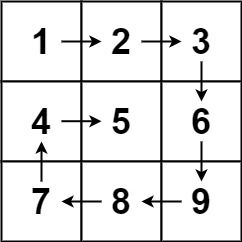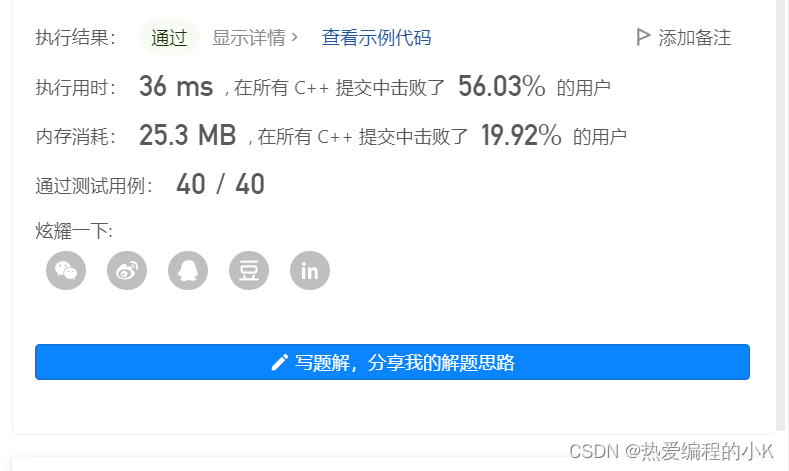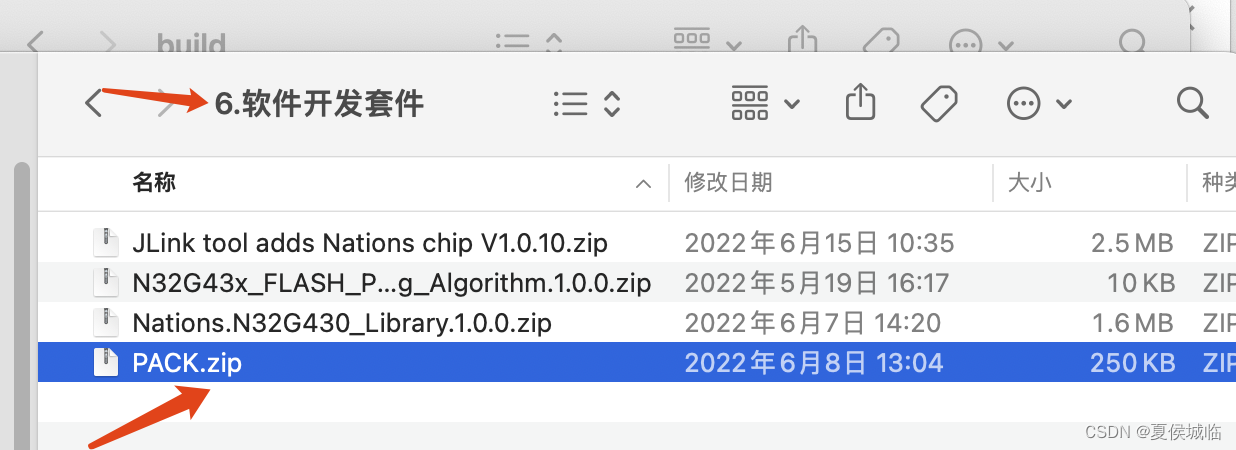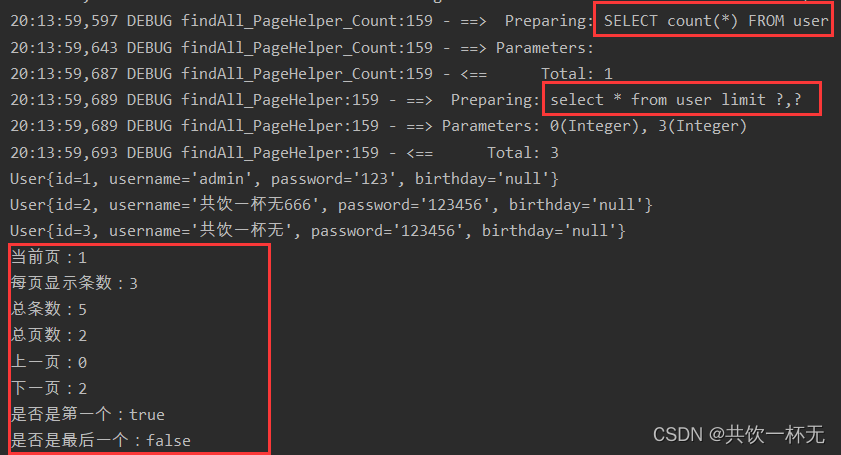
目录
1. 螺旋矩阵
2. LRU 缓存机制
3. 解数独
🌟 每日一练刷题专栏 🌟
Golang每日一练 专栏
Python每日一练 专栏
C/C++每日一练 专栏
Java每日一练 专栏
1. 螺旋矩阵
给你一个 m 行 n 列的矩阵 matrix ,请按照 顺时针螺旋顺序 ,返回矩阵中的所有元素。
示例 1:

输入:matrix = [[1,2,3],[4,5,6],[7,8,9]] 输出:[1,2,3,6,9,8,7,4,5]
示例 2:

输入:matrix = [[1,2,3,4],[5,6,7,8],[9,10,11,12]] 输出:[1,2,3,4,8,12,11,10,9,5,6,7]
提示:
m == matrix.lengthn == matrix[i].length1 <= m, n <= 10-100 <= matrix[i][j] <= 100
出处:
https://edu.csdn.net/practice/26654049
代码:
class Solution {
public List<Integer> spiralOrder(int[][] matrix) {
List<Integer> res = new ArrayList<Integer>();
if (matrix.length == 0 || (matrix.length == 1 && matrix[0].length == 0))
return res;
int left = 0;
int right = matrix[0].length - 1;
int top = 0;
int bottom = matrix.length - 1;
int num = (right + 1) * (bottom + 1);
while (num > 0) {
for (int j = left; j <= right; j++) {
res.add(matrix[top][j]);
num--;
}
if (num <= 0)
break;
top++;
for (int i = top; i <= bottom; i++) {
res.add(matrix[i][right]);
num--;
}
if (num <= 0)
break;
right--;
for (int j = right; j >= left; j--) {
res.add(matrix[bottom][j]);
num--;
}
if (num <= 0)
break;
bottom--;
for (int i = bottom; i >= top; i--) {
res.add(matrix[i][left]);
num--;
}
if (num <= 0)
break;
left++;
}
return res;
}
}2. LRU 缓存机制
运用你所掌握的数据结构,设计和实现一个 LRU (最近最少使用) 缓存机制。
实现 LRUCache 类:
LRUCache(int capacity)以正整数作为容量capacity初始化 LRU 缓存int get(int key)如果关键字key存在于缓存中,则返回关键字的值,否则返回-1。void put(int key, int value)如果关键字已经存在,则变更其数据值;如果关键字不存在,则插入该组「关键字-值」。当缓存容量达到上限时,它应该在写入新数据之前删除最久未使用的数据值,从而为新的数据值留出空间。
进阶:你是否可以在 O(1) 时间复杂度内完成这两种操作?
示例:
输入
["LRUCache", "put", "put", "get", "put", "get", "put", "get", "get", "get"]
[[2], [1, 1], [2, 2], [1], [3, 3], [2], [4, 4], [1], [3], [4]]
输出
[null, null, null, 1, null, -1, null, -1, 3, 4]
解释
LRUCache lRUCache = new LRUCache(2);
lRUCache.put(1, 1); // 缓存是 {1=1}
lRUCache.put(2, 2); // 缓存是 {1=1, 2=2}
lRUCache.get(1); // 返回 1
lRUCache.put(3, 3); // 该操作会使得关键字 2 作废,缓存是 {1=1, 3=3}
lRUCache.get(2); // 返回 -1 (未找到)
lRUCache.put(4, 4); // 该操作会使得关键字 1 作废,缓存是 {4=4, 3=3}
lRUCache.get(1); // 返回 -1 (未找到)
lRUCache.get(3); // 返回 3
lRUCache.get(4); // 返回 4
提示:
1 <= capacity <= 30000 <= key <= 100000 <= value <= 10^5- 最多调用
2 * 10^5次get和put
出处:
https://edu.csdn.net/practice/26654050
代码:
class LRUCache {
class Node {
Node prev, next;
int key, value;
Node(int _key, int _value) {
key = _key;
value = _value;
}
}
Node head = new Node(0, 0), tail = new Node(0, 0);
Map<Integer, Node> map = new HashMap<>();
int max_len;
public LRUCache(int capacity) {
max_len = capacity;
head.next = tail;
tail.prev = head;
}
public int get(int key) {
if (map.containsKey(key)) {
Node node = map.get(key);
remove(node);
add(node);
return node.value;
} else {
return -1;
}
}
public void put(int key, int value) {
if (map.containsKey(key)) {
remove(map.get(key));
}
if (map.size() == max_len) {
remove(head.next);
}
add(new Node(key, value));
}
private void remove(Node node) {
map.remove(node.key);
node.prev.next = node.next;
node.next.prev = node.prev;
}
private void add(Node node) {
map.put(node.key, node);
Node pre_tail = tail.prev;
node.next = tail;
tail.prev = node;
pre_tail.next = node;
node.prev = pre_tail;
}
}3. 解数独
编写一个程序,通过填充空格来解决数独问题。
数独的解法需 遵循如下规则:
- 数字
1-9在每一行只能出现一次。 - 数字
1-9在每一列只能出现一次。 - 数字
1-9在每一个以粗实线分隔的3x3宫内只能出现一次。(请参考示例图)
数独部分空格内已填入了数字,空白格用 '.' 表示。
示例:

输入:board = [["5","3",".",".","7",".",".",".","."], ["6",".",".","1","9","5",".",".","."], [".","9","8",".",".",".",".","6","."], ["8",".",".",".","6",".",".",".","3"], ["4",".",".","8",".","3",".",".","1"], ["7",".",".",".","2",".",".",".","6"], [".","6",".",".",".",".","2","8","."], [".",".",".","4","1","9",".",".","5"], [".",".",".",".","8",".",".","7","9"]] 输出: [["5","3","4","6","7","8","9","1","2"], ["6","7","2","1","9","5","3","4","8"], ["1","9","8","3","4","2","5","6","7"], ["8","5","9","7","6","1","4","2","3"], ["4","2","6","8","5","3","7","9","1"], ["7","1","3","9","2","4","8","5","6"], ["9","6","1","5","3","7","2","8","4"], ["2","8","7","4","1","9","6","3","5"], ["3","4","5","2","8","6","1","7","9"]] 解释:输入的数独如上图所示,唯一有效的解决方案如下所示:

提示:
board.length == 9board[i].length == 9board[i][j]是一位数字或者'.'- 题目数据 保证 输入数独仅有一个解
以下程序实现了这一功能,请你填补空白处内容:
···Java
class Solution {
boolean row[][] = new boolean[9][9];
boolean col[][] = new boolean[9][9];
boolean cell[][][] = new boolean[3][3][9];
public void solveSudoku(char[][] board) {
for (int i = 0; i < 9; i++) {
for (int j = 0; j < 9; j++) {
if (board[i][j] != '.') {
int t = board[i][j] - '1';
row[i][t] = col[j][t] = cell[i / 3][j / 3][t] = true;
}
}
}
dfs(board, 0, 0);
}
public boolean dfs(char[][] board, int x, int y) {
if (y == 9) {
x++;
y = 0;
}
if (x == 9)
return true;
____________________;
for (int num = 0; num < 9; num++) {
if (!row[x][num] && !col[y][num] && !cell[x / 3][y / 3][num]) {
board[x][y] = (char) (num + '1');
row[x][num] = col[y][num] = cell[x / 3][y / 3][num] = true;
if (dfs(board, x, y + 1))
return true;
board[x][y] = '.';
row[x][num] = col[y][num] = cell[x / 3][y / 3][num] = false;
}
}
return false;
}
}
```
出处:
https://edu.csdn.net/practice/26654051
代码:
class Solution {
boolean row[][] = new boolean[9][9];
boolean col[][] = new boolean[9][9];
boolean cell[][][] = new boolean[3][3][9];
public void solveSudoku(char[][] board) {
for (int i = 0; i < 9; i++) {
for (int j = 0; j < 9; j++) {
if (board[i][j] != '.') {
int t = board[i][j] - '1';
row[i][t] = col[j][t] = cell[i / 3][j / 3][t] = true;
}
}
}
dfs(board, 0, 0);
}
public boolean dfs(char[][] board, int x, int y) {
if (y == 9) {
x++;
y = 0;
}
if (x == 9)
return true;
if (board[x][y] != '.')
return dfs(board, x, y + 1);
for (int num = 0; num < 9; num++) {
if (!row[x][num] && !col[y][num] && !cell[x / 3][y / 3][num]) {
board[x][y] = (char) (num + '1');
row[x][num] = col[y][num] = cell[x / 3][y / 3][num] = true;
if (dfs(board, x, y + 1))
return true;
board[x][y] = '.';
row[x][num] = col[y][num] = cell[x / 3][y / 3][num] = false;
}
}
return false;
}
}🌟 每日一练刷题专栏 🌟
✨ 持续,努力奋斗做强刷题搬运工!
👍 点赞,你的认可是我坚持的动力!
🌟 收藏,你的青睐是我努力的方向!
✎ 评论,你的意见是我进步的财富!
☸ 主页:https://hannyang.blog.csdn.net/
 | Golang每日一练 专栏 |
 | Python每日一练 专栏 |
 | C/C++每日一练 专栏 |
 | Java每日一练 专栏 |



















